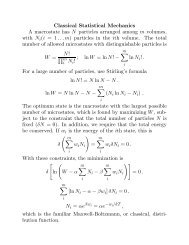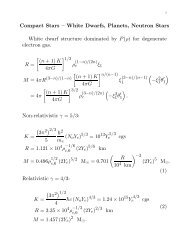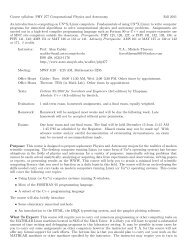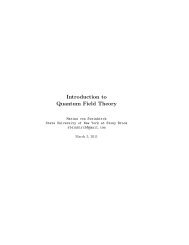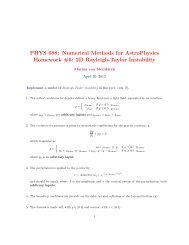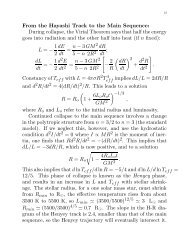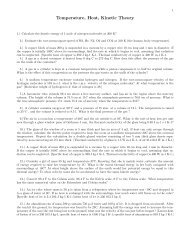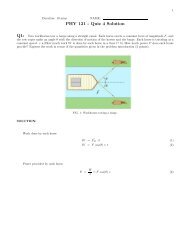You also want an ePaper? Increase the reach of your titles
YUMPU automatically turns print PDFs into web optimized ePapers that Google loves.
1<br />
<strong>Binary</strong> <strong>Stars</strong><br />
Consider a binary composed of two stars of masses M 1 and M 2 . We<br />
define M = M 1 + M 2 and µ = M 1 M 2 /M. If a 1 and a 2 are the mean<br />
distances of the stars from the center of mass, then M 1 a 1 = M 2 a 2 . The<br />
mean separation of the stars is a = a 1 + a 2 . If the orbit is elliptical with<br />
eccentricity e, then the separation at periastron is a(1 − e) and at apastron<br />
it is a(1 + e). The total energy and angular momentum of the binary are<br />
E = − 1 √<br />
GM 1 M 2<br />
J = µ GaM ( 1 − e<br />
2 a<br />
2) = µΩa 2√ 1 − e 2 .<br />
Kepler’s Law is<br />
( )<br />
Ω 2 2π 2<br />
= = GM<br />
P a 3 .<br />
The projected orbital velocity of star 1 is<br />
The quantity<br />
v 1 = Ωa 1 sin i.<br />
f 1 (M 1 ,M 2 ,i) = (M 2 sin i) 3<br />
M 2 = v3 1<br />
GΩ<br />
is known as the mass function since it depends only on observables v 1 ,P.<br />
If Doppler shifts from star 2 are measured, then<br />
f 2 (M 1 ,M 2 ,i) = (M 1 sin i) 3<br />
M 2 = v3 2<br />
GΩ<br />
can also be found. Then<br />
M 2<br />
= v 1<br />
M 1 v 2<br />
independent of i. If the binary is eclipsing, the angle i can be determined<br />
and the masses individually determined as well.<br />
Mass Transfer and Roche Lobes<br />
The total potential of a binary is<br />
−Φ = GM 1<br />
+ GM 2<br />
+ 1 r 1 r 2 2 d2 Ω 2 ,<br />
where r 1 and r 2 are the distances to stars 1 and 2 and d is the distance to<br />
the rotation axis. Restricting ourselves to the orbital plane, with the origin<br />
at the center of mass,<br />
GM<br />
−Φ(x,y) = 1 GM<br />
+ √ 2<br />
+ √(x 1 (<br />
x 2 + y 2) GM<br />
− a 1 ) 2 + y 2 (x + a 2 ) 2 + y 2 2 a 3 .
2<br />
In dimensionless coordinates ¯x = x/a, ȳ = y/a, m 1 = M 1 /M, m 2 = M 2 /M:<br />
⎡<br />
⎤<br />
−Φ(¯x,ȳ) = GM ⎢ m 1<br />
m<br />
⎣<br />
+ √ 2<br />
+<br />
a<br />
√(¯x 1 (<br />
¯x 2 + ȳ 2) ⎥<br />
⎦.<br />
− m 2 ) 2 + ȳ 2 (¯x + m 1 ) 2 + ȳ 2 2<br />
Contours of constant Φ are shown in the figure. There are deep minima at<br />
the stellar centers, and maxima at five so-called Lagrangian points. The L 1<br />
point between the stars is significant because if a star expands and reaches<br />
the potential surface passing through it, mass can be transferred to its<br />
companion.<br />
The equipotential surface that passes through L 1 is called the Roche<br />
lobe, and its size depends upon the mass ratio of the binary. Kopal (1959)<br />
gives for the radius R R with nearly the same volume as the Roche lobe:<br />
( )<br />
R 1/3<br />
R M1<br />
a = 0.46 . (1)<br />
M<br />
A better fit is by Eggleton:<br />
[<br />
R R /a = 0.49<br />
.6 +<br />
(<br />
M1<br />
M 2<br />
) −2/3<br />
ln<br />
(<br />
1 +<br />
(<br />
M1<br />
M 2<br />
) 1/3<br />
)] −1<br />
. (2)
3<br />
Assume the binary is circular. Then<br />
a =<br />
MJ 2<br />
GM 2 1 (M − M 1) 2,<br />
( ) ( )<br />
2a 2M1 da = − M<br />
dM<br />
M 1 M − M 1 , (3)<br />
1<br />
if dM = dJ = 0. This shows that if M 2 < M 1 , transferring mass from M 1<br />
to M 2 results in a shrinkage of the orbit. Am episode of conservative mass<br />
transfer in a binary results in<br />
a final = a initial<br />
(<br />
M1,initial M 2,initial<br />
M 1,final M 2,final<br />
) 2<br />
.<br />
Eq. (3) implies that in terms of the mass ratio of the binary, q = M 2 /M 1 ,<br />
da = 2a ( ) q − 1<br />
dq, (4)<br />
q 1 + q<br />
or a ∝ (1 + q) 4 q −2 . Expressing Eq. (1) in terms of q, then taking the<br />
derivative and combining with Eq. (4),<br />
da<br />
dR L = R L<br />
a − R [ ( ) ]<br />
L dq 2 q − 1<br />
3 1 + q = R 1<br />
L − dq.<br />
q 1 + q 3 (1 + q)<br />
This implies that the Roche lobe size reaches its minimum value when<br />
q = 6/5, or M 1 = 5M/11.<br />
On the other hand, suppose that mass is lost from one star in the form<br />
of a wind and is not accreted onto the companion. Then we might expect<br />
that<br />
M<br />
a final = a initial<br />
M − ∆M ,<br />
and mass loss will cause an increase in a binary’s separation.<br />
Now consider mass transfer when star 1 fills its Roche lobe. Stable mass<br />
transfer occurs when the change in radius of star 1 after transferring an<br />
increment of mass through the inner Lagrangian point is not offset by a<br />
corresponding change in the Roche radius, triggered by the new mass ratio<br />
of the binary. This requires that the logarithmic change of radius with mass<br />
for star 1 satisfies<br />
dln R<br />
dln M 1<br />
≡ α ≥ dln R R<br />
dln M 1<br />
= dln a<br />
dlnM 1<br />
+ 1 3 = 2 ( 2M1 − M<br />
M − M 1<br />
)<br />
+ 1 3 .
4<br />
In an equal mass binary, the first term vanishes. Generally, we can expect<br />
that this condition is generally satisfied. It is not, however, for a star with<br />
a convective envelope, for which γ = 5/3 and R ∝ M −1/3 .<br />
In some situations, mass transfer will be driven by losses of orbital angular<br />
momentum. The primary sources of angular momentum loss are magnetic<br />
braking and gravitational radiation. We have<br />
ȧ<br />
a = 2 J ˙ (<br />
J − 2 1 − M )<br />
2 M ˙ 2<br />
,<br />
M 1 M 2<br />
where the donor star is taken to be 2, so that M˙<br />
2 < 0. Using the simple<br />
Roche lobe formula,<br />
Ṙ R<br />
= 2 ˙ (<br />
J<br />
R R J − 2 1 − M )<br />
2 M ˙ 2<br />
+ 1 M˙<br />
2<br />
.<br />
M 1 M 2 3 M 2<br />
Assume that Ṙ2/R 2 = α( ˙ M 2 /M 2 , where α = −1/3 for a non-relativistic<br />
degenerate, or convective, star, and α = 1 for a main sequence star. For<br />
stable mass transfer, R 2 should remain equal to R R . Then we have<br />
(<br />
J˙ 5<br />
J = 6 + α 2 − M )<br />
2 M ˙ 2<br />
.<br />
M 1 M 2<br />
Since both sides of this equation must be negative, we find<br />
M 2<br />
M 1<br />
≤ 5 6 + α 2 .<br />
When α = −1/3(1), M 2 /M 1 ≤ 2/3(4/3). Gravitational radiation leads to<br />
J˙<br />
J = −32G3 5c 5 M 1 M 2 (M 1 + M 2 )<br />
a 4 s −1 . (5)<br />
Explosive Mass Loss<br />
Another case of mass transfer occurs after a supernova explosion, but<br />
here the mass loss is sudden and catastrophic and the companion does not<br />
accept the mass. If too much mass is lost from the system, the binary will be<br />
disrupted. The survival of the binary depends on the amount of mass loss,<br />
the phase of the binary (i.e., is it near periastron (a more stable situation)<br />
or apastron (a less stable situation)), and the magnitude and direction of<br />
any “kick” imparted to the supernova remnant star. If the explosion is
5<br />
perfectly symmetric, the kick velocity is zero. However, if the explosion is<br />
asymmetric, the kick velocity is determined by momentum conservation. A<br />
1% asymmetry in the neutrinos released in a supernova could impart a kick<br />
velocity of approximately<br />
∆V = ∆E<br />
M ns c<br />
≃ 360 kms−1<br />
assuming a neutron star mass of M ns = 1.4 M ⊙ and ∆E = 3 × 10 51 erg.<br />
This, in many cases, exceeds the relative orbital velocities of the stars prior<br />
to the explosion. As we will see, a kick in the direction of orbital motion of<br />
the remnant destabilizes the system, but a reverse kick can stabilize it.<br />
Following J. Hills, Ap. J. 267 (1983) 322, the total energy of the binary<br />
prior to the explosion is<br />
E o = − GMo 1 M 2<br />
= − GMo 1 M 2<br />
2a o r<br />
+ 1 2 µ oV 2 o<br />
where the subscript o refers to the initial system. r is the instantaneous<br />
separation of the two stars (equal to a o if the orbit is circular). At periastron,<br />
r = a o (1 − e o ) and at apastron, r = a o (1 + e o ). µ o = M1 oM 2/M o<br />
is the reduced mass and M o is the initial total mass. V o is the initial relative<br />
velocities of the two stars. We can furthermore define a parameter<br />
Vc 2 = GM o/a o as the relative velocity in the circular orbit case.<br />
Immediately after the explosion, if the orbit is still bound, we have<br />
E = − GM 1M 2<br />
2a<br />
= − GM 1M 2<br />
r<br />
+ 1 2 µV 2<br />
by comparison, where µ = M 1 M 2 /M. Defining ∆M = M o 1 −M 1 = M o −M,<br />
it is straightforward to demonstrate that<br />
a<br />
a o<br />
=<br />
1 − ∆M/M o<br />
1 − (2a o /r)(∆M/M o ) + ( V 2<br />
o − V 2) /Vc<br />
2 .<br />
In order to remain bound, it is therefore necessary that a < ∞, or<br />
∆M<br />
< r (<br />
1 − V o 2 − V 2 )<br />
.<br />
M o 2a o<br />
Several cases can now be considered. If the explosion occurs on a<br />
timescale short compared to the orbital period, and if no kick is imparted<br />
V 2 c
6<br />
to the supernova remnant star, it is reasonable to assume that V = V o , i.e.,<br />
the relative velocities of the two stars remains the same. In this case, the<br />
condition for stability becomes<br />
∆M<br />
M o<br />
< r<br />
2a o<br />
.<br />
If the orbit is initially circular, the RHS of the above is simply 1/2. If the<br />
initial orbit is elliptical, the RHS of the above is in the range (1 − e o )/2 −<br />
(1 + e o )/2, depending on the precise value of r when the explosion occurs.<br />
In the limit that the initial eccentricity is unity, it is therefore possible<br />
both that very little mass loss could disrupt the orbit, if the stars are near<br />
apastron, or that the binary could remain stable in spite of losing almost<br />
all the binary’s mass, if the stars are near periastron.<br />
If the supernova remnant star receives a kick velocity, which is directed<br />
at an angle of cosθ with respect to ⃗ V o , we find<br />
⃗V = ⃗ V o + ⃗ ∆V , ⃗ V · ⃗ V = V 2 = V 2 o + 2V o ∆V + (∆V ) 2 .<br />
Therefore, the condition for stability becomes<br />
∆M<br />
< r [<br />
1 − ∆V (∆V + 2V ]<br />
o cos θ)<br />
M o 2a o Vc<br />
2 .<br />
In the case that the kick is exactly (mis)aligned with ⃗ V o , we have that<br />
cos θ = +1(−1). Comparing the limiting amounts of mass loss for stability<br />
in the two cases, denoted ∆M + and ∆M − , respectively, we find<br />
∆M + − ∆M −<br />
M o<br />
= − 2r<br />
a o<br />
V o ∆V<br />
V 2 c<br />
< 0.<br />
This means that a kick in the same direction as the orbital motion tends<br />
to destabilize the orbit, while a misaligned kick stabilizes the orbit. In the<br />
case of a circular initial orbit and a misaligned kick, one has<br />
∆M<br />
M o<br />
= 1 2<br />
[<br />
1 + ∆V<br />
V 2 c<br />
]<br />
(2V c − ∆V ) .<br />
If the kick velocity magnitude is comparable to the relative orbital speed in<br />
this case, one has ∆M < M o for stability, i.e., no amount of mass loss can<br />
disrupt the orbit! An oppositely directed kick of this size, however, always<br />
disrupts the binary.



